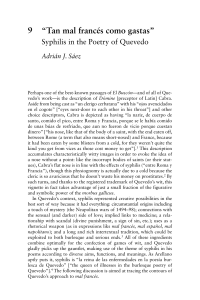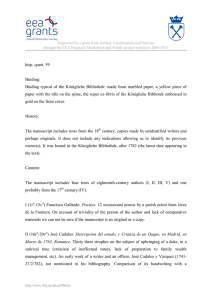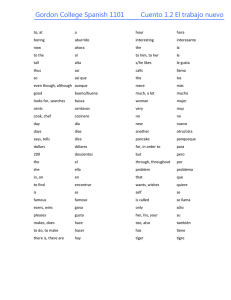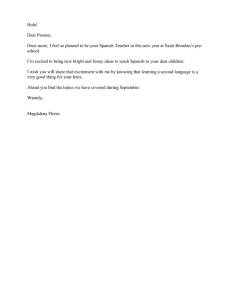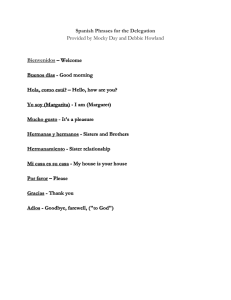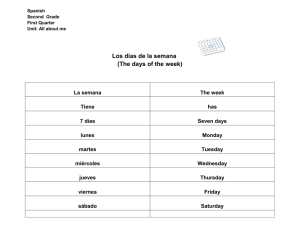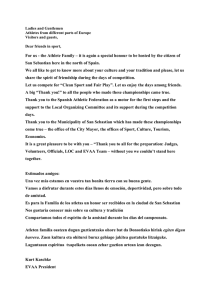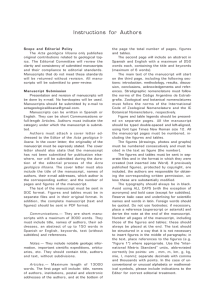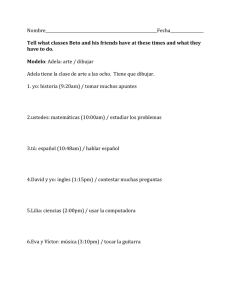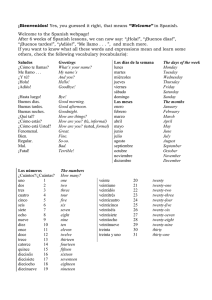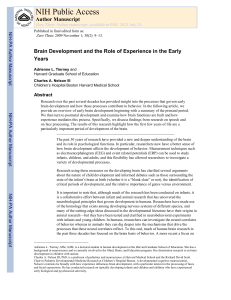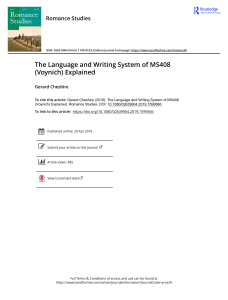HISP. QUART. 20 Francisco de Quevedo: Varios papeles satíricos
Anuncio
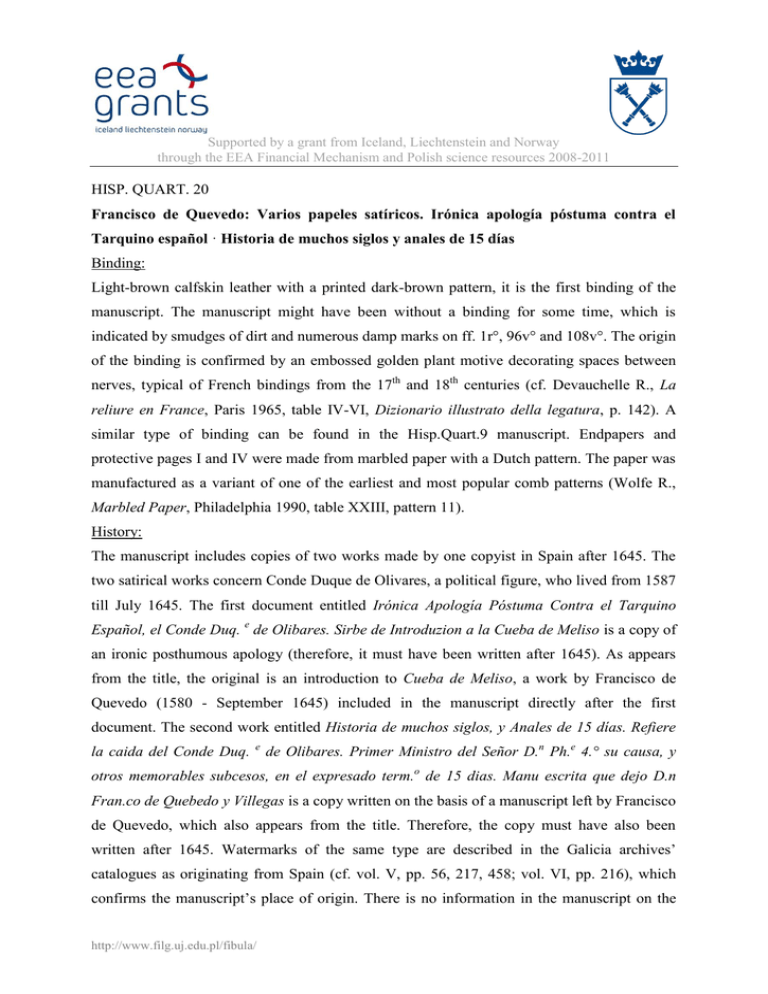
Supported by a grant from Iceland, Liechtenstein and Norway through the EEA Financial Mechanism and Polish science resources 2008-2011 HISP. QUART. 20 Francisco de Quevedo: Varios papeles satíricos. Irónica apología póstuma contra el Tarquino español · Historia de muchos siglos y anales de 15 días Binding: Light-brown calfskin leather with a printed dark-brown pattern, it is the first binding of the manuscript. The manuscript might have been without a binding for some time, which is indicated by smudges of dirt and numerous damp marks on ff. 1r°, 96v° and 108v°. The origin of the binding is confirmed by an embossed golden plant motive decorating spaces between nerves, typical of French bindings from the 17th and 18th centuries (cf. Devauchelle R., La reliure en France, Paris 1965, table IV-VI, Dizionario illustrato della legatura, p. 142). A similar type of binding can be found in the Hisp.Quart.9 manuscript. Endpapers and protective pages I and IV were made from marbled paper with a Dutch pattern. The paper was manufactured as a variant of one of the earliest and most popular comb patterns (Wolfe R., Marbled Paper, Philadelphia 1990, table XXIII, pattern 11). History: The manuscript includes copies of two works made by one copyist in Spain after 1645. The two satirical works concern Conde Duque de Olivares, a political figure, who lived from 1587 till July 1645. The first document entitled Irónica Apología Póstuma Contra el Tarquino Español, el Conde Duq. e de Olibares. Sirbe de Introduzion a la Cueba de Meliso is a copy of an ironic posthumous apology (therefore, it must have been written after 1645). As appears from the title, the original is an introduction to Cueba de Meliso, a work by Francisco de Quevedo (1580 - September 1645) included in the manuscript directly after the first document. The second work entitled Historia de muchos siglos, y Anales de 15 días. Refiere la caida del Conde Duq. e de Olibares. Primer Ministro del Señor D.n Ph.e 4.° su causa, y otros memorables subcesos, en el expresado term.o de 15 dias. Manu escrita que dejo D.n Fran.co de Quebedo y Villegas is a copy written on the basis of a manuscript left by Francisco de Quevedo, which also appears from the title. Therefore, the copy must have also been written after 1645. Watermarks of the same type are described in the Galicia archives’ catalogues as originating from Spain (cf. vol. V, pp. 56, 217, 458; vol. VI, pp. 216), which confirms the manuscript’s place of origin. There is no information in the manuscript on the http://www.filg.uj.edu.pl/fibula/ Supported by a grant from Iceland, Liechtenstein and Norway through the EEA Financial Mechanism and Polish science resources 2008-2011 copyist or any subsequent owners. Lack of accession number indicates that the manuscript reached the Kongliche Bibliothek in Berlin before 1828, when the accession register was established. Content: I (1r°-96v°) The manuscript includes satirical works concerning Conde Duque de Olivares, who lived between 1587-1645 and his actions. Conde Duque de Olivares or Gaspar de Guzmán y Pimentel Ribera y Velasco do Tovar served many functions at the court of Philip IV. In the end he assumed a post of a minister and his controversial internal (reforms) and foreign (war activities) policy ruined the country in economic terms, led to conflicts with most European countries and embroiled Spain in the Thirty Years’ War. As a result, Conde Duque had to leave Castile in 1643 and in 1644 the Inquisition brought a suit against him (www.wikipedia.es/wiki/Conde-Duque_de_Olivares). The first document entitled Irónica Apología Póstuma Contra el Tarquino Español, el Conde Duq. e de Olibares. Sirbe de Introduzion a la Cueba de Meliso is a copy of an ironic posthumous apology. As appears from the title the original was the introduction to Cueva de Meliso, a work by Francisco de Quevedo (1580-1645). This part also includes a copy of La Cueva de Meliso as well as footnotes to the text. It is a satirical work concerning the rule of the hated minister Gaspar de Guzmán which lasted for 22 years. The text refers to minister’s life presenting successive stages of his career. The stressed elements include minister’s bad ˝manners˝, the fact that he used services of astrologists and witches in his actions against his political opponents, pitiful results of introduced reforms and incompetent activity at the international arena. The text is interlarded with dialogues between Gaspar and Meliso and provided with 72 footnotes. The available materials include: a monograph by Comellas Aguirrezábal M.M. Un manuscrito sevillano desconocido de 'La Cueva de Meliso': diálogo satírico contra el Conde-Duque de Olivares published in the 225th issue of Revista histórica, literaria y artística, 1991, pp. 71119, an article published in 1996 in the 7th issue of the Extramundi y los papeles de Iria Flavia. Revista Trimestral Fundada por Camilo José Cela magazine, as well as an article by Beatriz Moncó El relato histórico como metáfora cultural published by the Universidad http://www.filg.uj.edu.pl/fibula/ Supported by a grant from Iceland, Liechtenstein and Norway through the EEA Financial Mechanism and Polish science resources 2008-2011 Complutense. The text was compared with the following manuscript copies available at the Biblioteca Nacional de España: Papeles varios, the 18th century: Irónica apología póstuma contra el Tarquino español, el Conde Duque de Olivares ff. 1v°-82v° (catalogue number MSS/11042; no significant differences between the texts except for a couple of divergences in isolated fragments, also includes the La cueva de Meliso text and footnotes); Papeles varios, the 18th century: La cueva de Meliso: apología contra el Tarquino español, Conde Duque de Olivares ff. 189r°-226r° (catalogue number MSS/11075, no significant differences between the texts except for a couple of divergences in isolated fragments, a note at the end saying that notes are in a separate notebook); Papeles referentes al Conde Duque de Olivares, the 18th century: Choronica, apología posthuma contra el Tarquino Español Don Gaspar de Guzmán: sirve de introducción la cueva de Meliso ff. 99r°-148v° (catalogue number MSS/ 10659; lack of introduction in the form of Apología póstuma; pages 99r°-v° include a note concerning work’s authorship, according to which Francisco de Quevedo is not the author of the manuscript and the real author is called Don Francisco de la Rioja, a member of the High Council of Inquisition and a librarian of King Philip IV, includes seventy notes on the margins; lack of significant differences between the texts); Papeles varios, the 18th century: La cueva de Meliso ff. 1r°-122v° (MSS/19328; includes an introduction in the form of Apología póstuma, no significant differences between the texts, it is the most similar copy, notes to the text are provided in the same way – they are ruled off with a horizontal line, lack of 72 notes). A publication entitled Don Francisco de Quevedo y Villegas. Obras completas, introduction, study and footnotes by Felicidad Buendía, Madrid 1988 includes many valuable information on the author, his works, critical editions, and bibliographies connected with his creative work. II (97r°-108v°) Content of the second work entitled Historia de muchos siglos, y Anales de 15 días. Refiere la caida del Conde Duq. e de Olibares. Primer Ministro del Señor D.n Ph.e 4.° su causa, y otros memorables subcesos, en el expresado term.o de 15 dias. Manu escrita que dejo D.n Fran.co de Quebedo y Villegas refers to the fall of rules of Conde Duque de Olivares, feelings in many regions of Spain and Europe connected with his dismissal and results of these events influencing Spain. King Philip III died in 1621 and Francisco de Quevedo was http://www.filg.uj.edu.pl/fibula/ Supported by a grant from Iceland, Liechtenstein and Norway through the EEA Financial Mechanism and Polish science resources 2008-2011 imprisoned in the Torre de Juan Abad. The work was written in captivity in 1621 and had changes introduced to it in 1636 (the author added the following fragments: Continuación a la historia de quince días and Añadido a la historia y la vida de Juan de Spina). It is assumed to be a sketch of a much bigger work which the author planned to write. Many manuscript copies were made, but Quevedo did not wish for his work to be published in print during his lifetime. It was published separately for the first time in 1787 by Antonio Valladares in Semanario erudito, and included in a collection in 1851. The following articles refer to the discussed work: V. Roncero López Los „Grandes Anales de Quince Días”: Literatura e Historia published by the State University of New York and J. Villalba Álvarez La presencia de Tácito en “Los Grandes Anales de Quince Días,” de Francisco de Quevedo. Una visión tacítea de España published by the University of Extremadura. As appears from information provided in the following critical edition Don Francisco de Quevedo y Villegas. Obras completas. Introduction, edition and footnotes by Felicidad Buendía (Madrid 1988, p. 817) many copies of the work were written and systematically modified on account of the changing political situation. Many information concerning changes introduced to individual copies can be found in the study entitled Los grandes anales de quince días de Quevedo. Edition and study by Victoriano Roncero López, Madrid 1988, pp. 149-247. The text was compared with the following manuscript copies available in the Biblioteca Nacional de España: Quevedo F., Grandes anales de 15 días, copy by Felix de Salabert y Aguerri, Madrid 1736 (catalogue number MSS/10746; comparison of the texts showed that Hisp.Qu.20 includes only a fragment of the whole work or its later/earlier, modified version, major differences between the texts); Quevedo F., Obras en prosa y verso, the 18th century: Grandes anales de quince días ff. 71r°-271v° (MSS/10795; differences similar as in the case of MSS/10746); Varias obras en verso y prosa de Don Francisco de Quevedo, the 18th century: Grandes anales de quince días ff. 2r°-97v° (MSS/10387; minor differences in texts in comparison with the previous two copies and major differences in comparison with Hisp.Qu.20); Grandes anales de quince días, the 17th century (catalogue number MSS/18660/7; similar to the previous three copies); Papeles varios, the 18th century: Historia de muchos siglos : anales de 15 días y tres coronas en el aire ff. 243r°-253r° (MSS/19328; no differences between the texts, includes the same fragments with the most important information highlighted in a similar way) as well as http://www.filg.uj.edu.pl/fibula/ Supported by a grant from Iceland, Liechtenstein and Norway through the EEA Financial Mechanism and Polish science resources 2008-2011 with the following critical editions: Don Francisco de Quevedo y Villegas. Obras completas. Introduction, edition and subtitles by Felicidad Buendía, Madrid 1988 (catalogue number 9/049411; as in the following cases MSS/10746, MSS/10795, MSS/10387 and MSS/18660/7); Los grandes anales de quince días de Quevedo. Edition and study by Victoriano Roncero López, Madrid 1988 (3/169963; includes texts of the second and third editions of the work, which are similar to the four above-mentioned manuscripts, additionally a list of all manuscript copies of the work, pp. 230-247). http://www.filg.uj.edu.pl/fibula/
